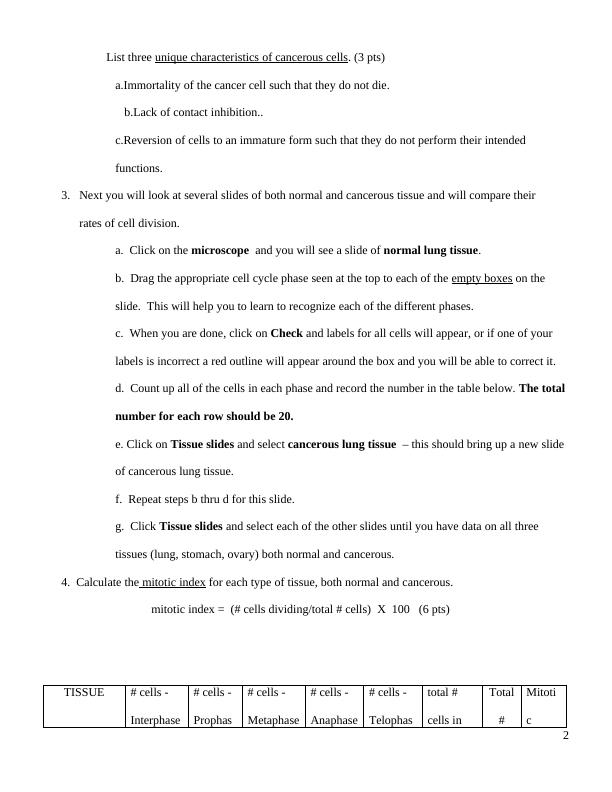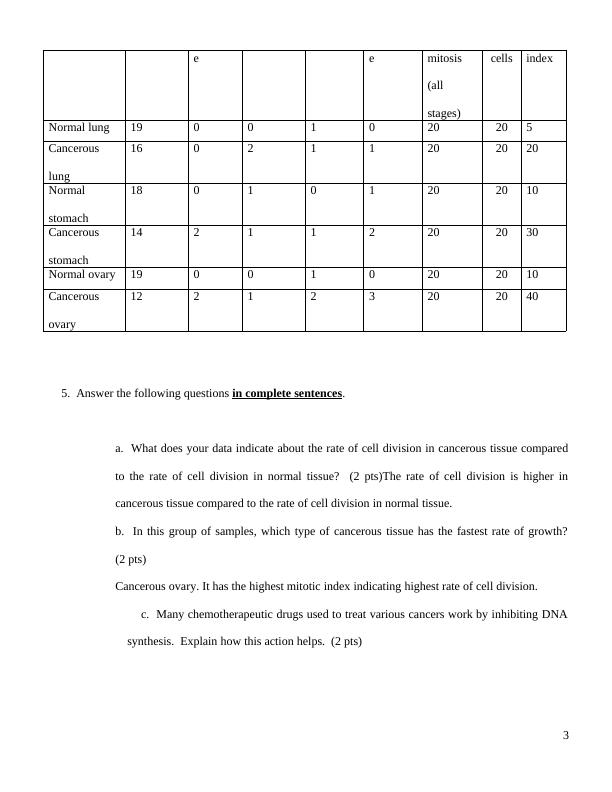Assignment on Exploration of the Cell Cycle and Cancer
Added on 2020-04-07
8 Pages1418 Words94 Views
Ch 3 Act 9 - Exploration of the cell cycle and cancer (22 pts)Objectives:become familiar with the stages of the cell cycle and mitosiscompare normal cell division with that seen in cancerous cellsComplete this assignment by following the directions on this handout rather than those on the screen.1.First click on “audio” and then click on the monitor in the illustration to view the video about the cell cycle. As you do this, answer the following:In what form is the DNA of the cell during interphase? _It is in form of loosely packed chromatin that is spread throughout the nucleus.________Besides the DNA, what else required for cell division is doubled during interphase? _______The mitochondria double ___________What holds sister chromatids together? ___The Cohesin_______________During which phase are the sister chromatids split apart? _Anaphase_________________(4 pts)2.Click the “Information” button in the bottom right corner of the lab simulation. Read all of the background information on cancer and the cell cycle. As you do:List three examples of ways in which cells can become cancerous. (3 pts) a. Through rapid multiplication of cells b.Through genetic mutation c. viruses can also cause cells to be cancerous. Most notably, especially cervical cancer resultsfrom viruses in most cases. . 1

List three unique characteristics of cancerous cells. (3 pts)a.Immortality of the cancer cell such that they do not die. b.Lack of contact inhibition.. c.Reversion of cells to an immature form such that they do not perform their intended functions.3.Next you will look at several slides of both normal and cancerous tissue and will compare their rates of cell division.a. Click on the microscope and you will see a slide of normal lung tissue.b. Drag the appropriate cell cycle phase seen at the top to each of the empty boxes on the slide. This will help you to learn to recognize each of the different phases.c. When you are done, click on Check and labels for all cells will appear, or if one of your labels is incorrect a red outline will appear around the box and you will be able to correct it. d. Count up all of the cells in each phase and record the number in the table below. The total number for each row should be 20.e. Click on Tissue slides and select cancerous lung tissue – this should bring up a new slide of cancerous lung tissue.f. Repeat steps b thru d for this slide. g. Click Tissue slides and select each of the other slides until you have data on all three tissues (lung, stomach, ovary) both normal and cancerous.4. Calculate the mitotic index for each type of tissue, both normal and cancerous. mitotic index = (# cells dividing/total # cells) X 100 (6 pts)TISSUE# cells - Interphase# cells - Prophas# cells -Metaphase# cells -Anaphase# cells -Telophastotal # cells in Total#Mitotic 2

eemitosis (all stages)cellsindexNormal lung19001020205Cancerous lung160211202020Normal stomach180101202010Cancerous stomach142112202030Normal ovary190010202010Cancerous ovary1221232020405. Answer the following questions in complete sentences. a. What does your data indicate about the rate of cell division in cancerous tissue comparedto the rate of cell division in normal tissue? (2 pts)The rate of cell division is higher incancerous tissue compared to the rate of cell division in normal tissue.b. In this group of samples, which type of cancerous tissue has the fastest rate of growth?(2 pts)Cancerous ovary. It has the highest mitotic index indicating highest rate of cell division. c. Many chemotherapeutic drugs used to treat various cancers work by inhibiting DNA synthesis. Explain how this action helps. (2 pts)3

End of preview
Want to access all the pages? Upload your documents or become a member.